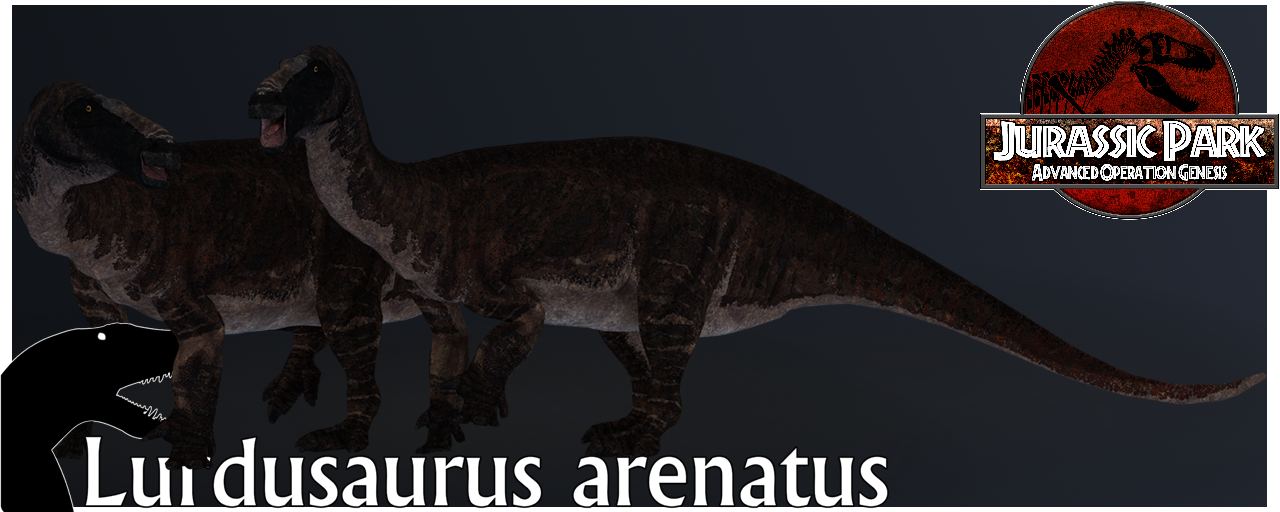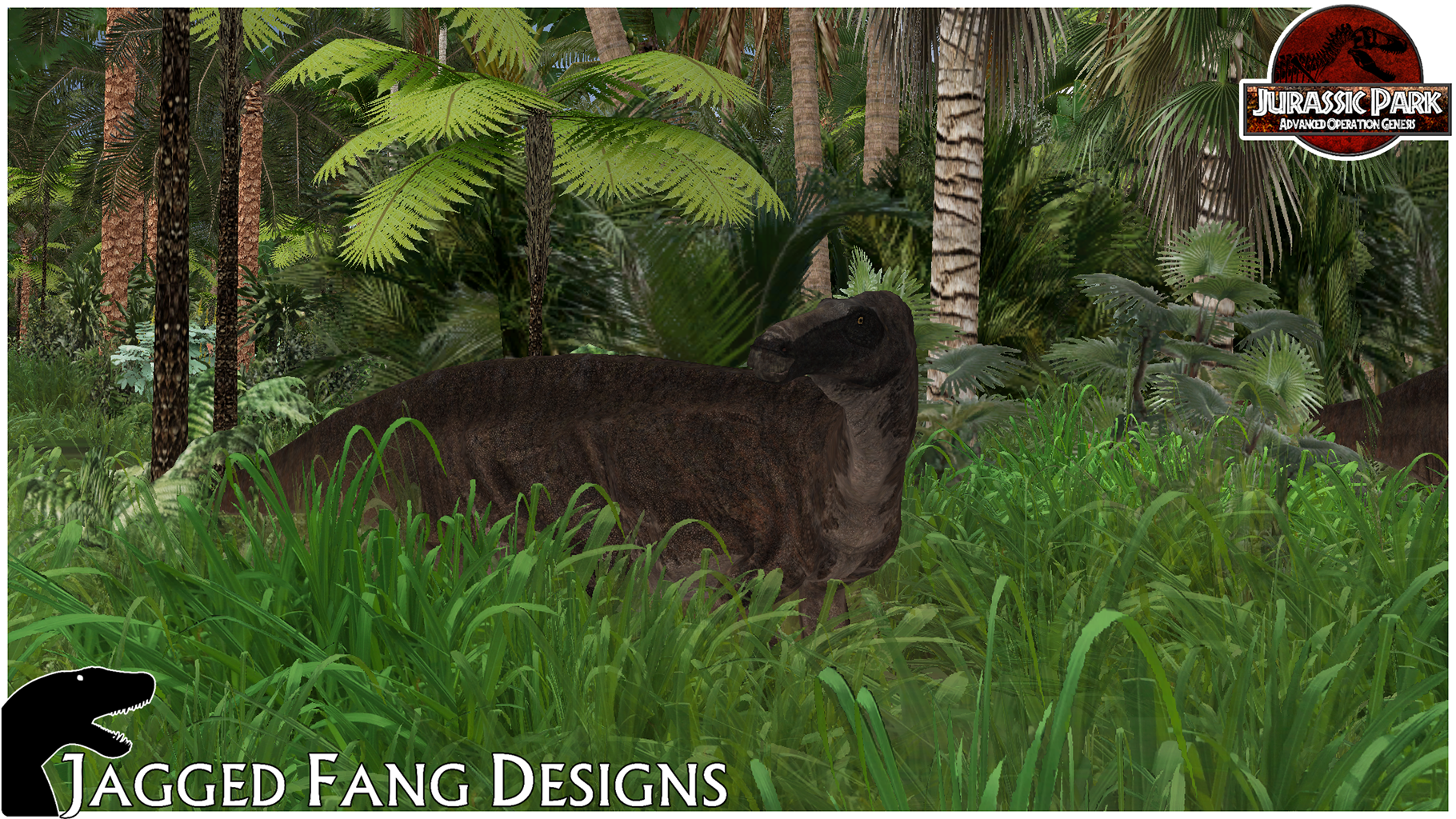

Species: L. arenatus
Animal class: Large
Containment procedure:
Due to specific behavioural patterns, entry to L. arenatus exhibits and containment areas requires Class Three (3) clearance from the owning parks board of directors. Staff entering such containment areas must be equipped with standard Class Four (4) Herbivore-repellent Suits to stop the animals from approaching staff, or alternatively the herd is to be mustered by standard Herdsman drones into a secondary containment paddock. Staff supposed to cater to L. arenatus’ needs possessing no prior experience in handling large Ornithopods is to be put through two(2) sessions of basic training and then must pass a mandatory test with grade 90% or higher before being allowed entry to the exhibit.
L. arenatus are known to be particularly unfussy in terms of feeding, most of the time it is advisable to allow them to browse on the non-toxic foliage within the exhibit, promoting natural behaviours, while also feeding them non-citrus fruit and supplementing their diet with freely available cuttlebone. If access to fresh, living plants is denied, L. arenatus will begin testing the perimeters, attempting to migrate to more habitable land, which may result in containment breach. In case of containment breach, park personnel are expected to enact Class Four (4) Large Ornithopod Containment procedures with attempts at using Herdsman drones beginning immediately after the staff is notified of the containment breach.
Paddocks are to be constructed of MEDIUM clearance fencing and the herds should consist of no fewer than three (3) mated pairs or six (6) individuals. Suggested main containment area size is 100x300 metres for up 6 animals with increase of space by a 100x100 metre worth of land with every added pair or 50x50 metre with every added non-mated animal. Preferable scenery is sparse woodland with a watering hole in the form of a small pond or shallow lake in the centre. L. arenatus herds are to be granted access to soft, moist ground in the form of muddy hole or lake shore, in which they will wallow daily, or, in nesting season, weekly. L. arenatus are known to be temperamental if perimeter fencing puts them next to large theropods or, in mixed modern zoos, large mammals. It is a priority to construct this species’ paddocks in a well suited environment, as keeping it calm and free of stress increases longevity, promotes more desirable natural behaviours and reduces chances of containment breaches paired up with heavy loss in human life, and thus chances of financial crisis.

History & Description:
L. arenatus is one of the latest additions to parks featuring Mesozoic wildlife around the world, it was first introduced in St. Petersburg Prehistoric Animal Research Centre, year [REDACTED] and managed to slowly gain popularity of solid three (3) stars in parks, as well as mediocre popularity among wealthy private collectors. Primary colour of this animal is brown with heavily varied faint patterning and strong, cream coloured underside, as well as a facial “mask”, reminiscent of those worn by extant ungulates. Such pigmentation allows it to remain relatively undetected in its preferred habitat, which is sparse woodlands full of easily-accessible low-growing trees, from which L. arenatus browses throughout most of its day.
History of this animal is full of controversy among naturalists, not so much among thrill seekers. It was quickly discovered that it is one of the few species brought back that has particular lack of fondness of mammals. First hints towards this state of the matters were acquired by research staff in the facility that brought L. arenatus back to life. Three (3) personnel were mauled to death before proper containment protocols were developed and extensive study confirmed that it is not possible to tame or domesticate this species. In a preserve in Zambezian woodlands there have been attempts at introducing a herd of L. arenatus to an environment wiped almost clean of modern life by [REDACTED] incident, however the herd migrated out of the preserve and started wreaking havoc among local wildlife in neighbouring ecosystems, oftentimes attacking herds of large mammals in attempt to drive them away from newly acquired territory, as well as attempting to collectively seek and destroy any local predatory mammals, a behaviour which is quite consistent with why this species is not allowed anywhere near mammalian predators in modern mixed zoos and wildlife parks.
Normally, a species this aggressive to others would be considered undesirable among parks exhibiting large number of dinosaurs, however there is also the other side of L. arenatus – a somewhat gentle giant, at least to its own kin and very few species it happens to get along with. L. arenatus herds are tightly-knit and consist of pairs that mate for life, with dominant pair always nesting in the middle while subordinate pairs create a colony of nests around them, also filling fake nests with unfertilized eggs on the outskirts of the colony. Such nesting colony of this species might reach even 50m in diameter and the brooding pairs will furiously attack any non-tolerable species approaching it. Among clades (which is important, because this species seems to pick its coinhabitants based on general morphology) that have been considered safe for keeping with L. arenatus are animals like less temperamental ankylosaurians, small and medium-sized sauropods, as well as other ornithopods. Ceratopsians are also well received. Ceratopsians in general are ill-advised and should also be avoided at any cost as inhabitants of neighbouring enclosures. Lurdusaurus arenatus is one of the few extinct species that is plagued by modern external parasites and thus it is advised to make their exhibit open to allow local birds to help it out by picking any invertebrates trying to make its skin their home. Surprisingly, this species shows incredible resilience to modern bacterial- and viral diseases and will not contract them during such sanitary procedures, making the usage of local wildlife much less expensive than biweekly parasite treatment that endangers the life off the staff in case of too weak dosage of tranquilisers. No Lurdusaurus are known to become feral, mostly because [REDACTED] has almost entirely eradicated it from illegal trade and attempts from wealthy collectors that were unprepared to deal with this animal have rendered them educated and humbled or crippled, or dead for the better of this world’s ecosystems. In case of any sightings of feral individuals or herds, it is a priority to inform nearest prehistoric wildlife facility to enact recapture protocols, as L. arenatus is highly destructive and it’s been deemed vital to prevent finding out just how invasive this species can become.




This dinosaur has always been curious to me, is like crossing an iguanodont with a small sauropod.
This comment is currently awaiting admin approval, join now to view.
WeEklY uPdATeS